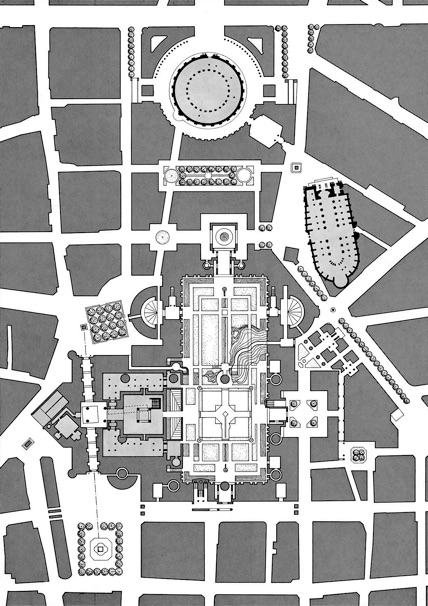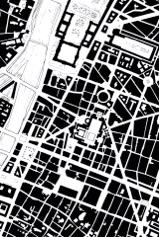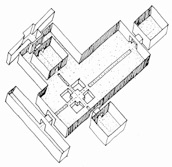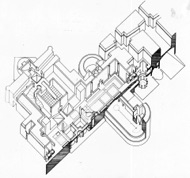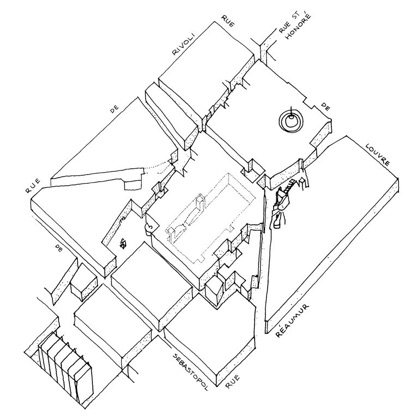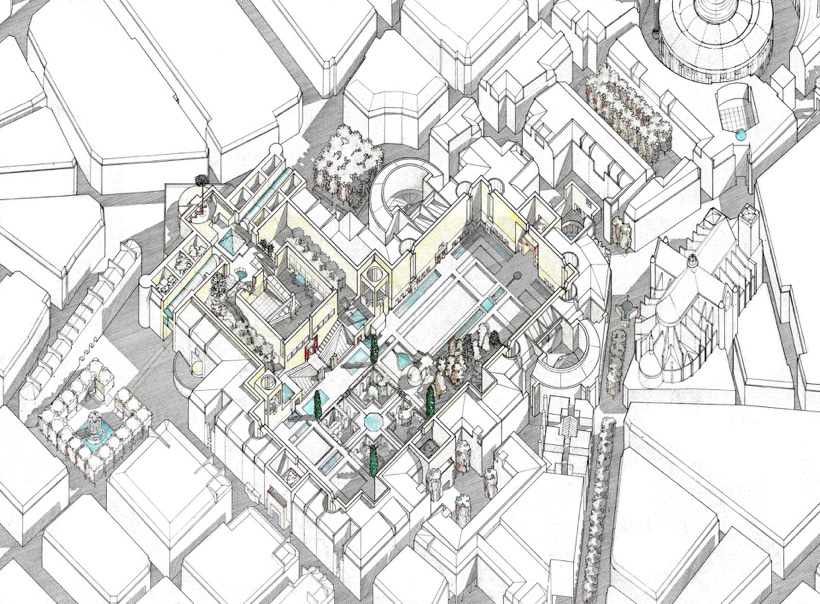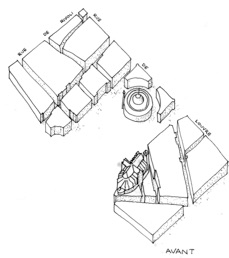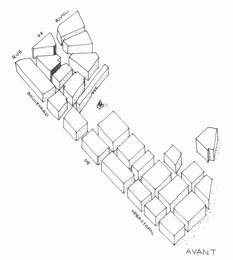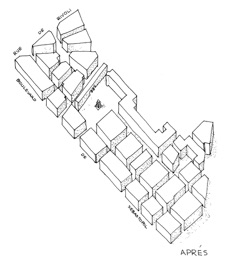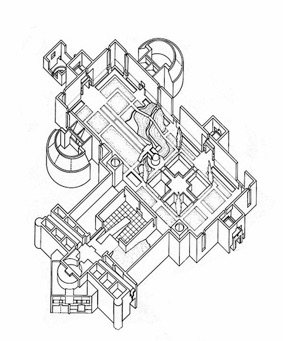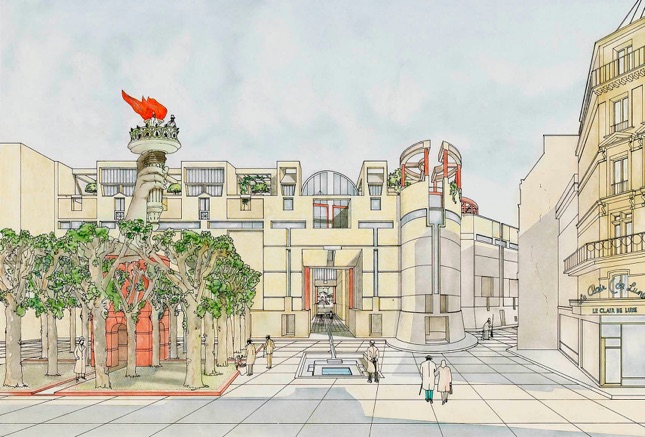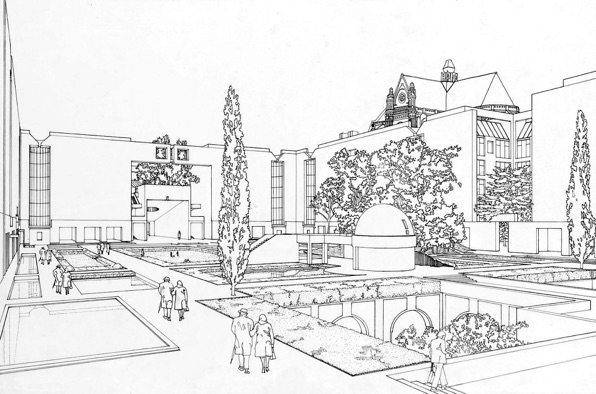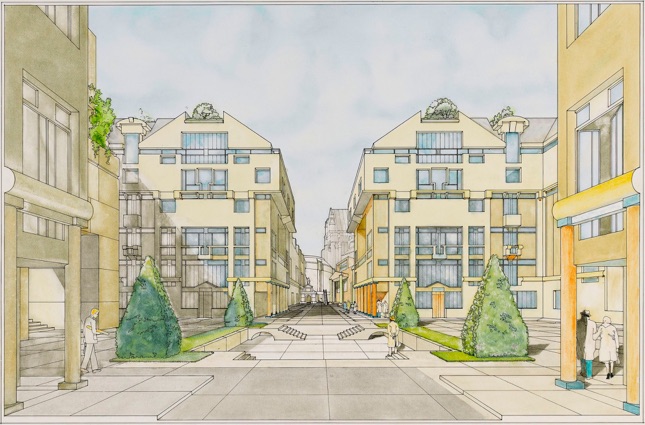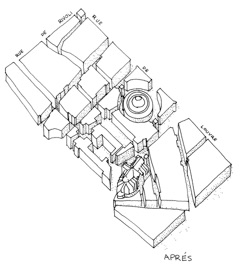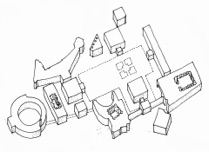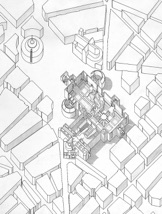Click on any image for a larger version


c.Continuity of texture
The discontinuity of these boundaries (Rue Rambuteau and the Rue Berger) also facilitates a more complex north / south continuity of new textures. At the western end, a new field joins the blocks below and above the site through new residential squares. (11,12)
A local public space is created around the church of St Eustache as a new focus for these neighborhoods. To the east, the existing group of blocks is at present divided by the gap of the Place des Innocents. They are joined in a new field that establishes a broader boundary formed by a proposed bent wall of housing wrapping the inner precinct. The north and south groups of blocks thereby encompass the Place des Innocents that is restored to its original historic size. The Rue Lescot, formerly the eastern edge of the market site, can now be understood as a new center penetrating the middle of the Place des Innocents and linking a sequence of spaces running north from the Rue de Rivoli to the Rue Turbigo. In addition, the northern texture is expanded around the air conditioning plant serving the shopping center below, concealing it from within the site. (13,14)
In part, the location and size of the inner precinct space results from the specific requirements of completing these textures, but it is also a consequence of other site conditions. These suggest that the present site must be divided into several sub-compositions that limit the size and location of public spaces. Therefore, the solution for the major plan element must be smaller than the available site.
d.Existing axes
The existing axis between the Bourse and the Forum is in itself a dilemma. This arbitrary alignment is left over from the design of the Baltard’s market halls and its continued accentuation produces a false emphasis between inappropriate things – the back of the Bourse and the light well for an underground shopping center. To emphasize this axis would make them dominant symbols.
To avoid extending the Bourse’s influence, it is more appropriately confined to its own space and defined by a limited context. This stabilizes its position and reinforces its frontal orientation toward the Rue de Louvre. Connections to the rear are deliberately made off axis, one extending obliquely from the column, the other connecting through the Hotel courtyard to the façade of St Eustache as an extension of the Rue de Jour. Similarly, this east / west axis is eliminated in the Forum light-well. The Forum is remodeled into a series of grottoes that appear to be sunken parterres from the surrounding garden. Its visible dimensions are made to serve the space above, while a portion of it is enclosed under a skylight to form a central hall for the shopping levels below. (15)
make each part more manageable and comprehensible: the result is to support discrete architectural components more than complex urban elements. The functional program as a determinant is invariably too inflexible because it fixes identities and relationships in precise building form, thus limiting the interpretations of an urban design by restricting change, alternatives, and re-use. Both the program and technical analysis encourage the divisive extrapolation of those elements that once formed a cohesive, traditional urbanism.
The first step toward defining the objective of urbanism is to differentiate between the appropriate methods of architecture and those of urban design. It is necessary to recognize that the familiar frameworks that stress architectural unity, singular imagery and comprehensive identity are contrary to reconstructing the city fabric. Urbanism assumes architecture within it and attempts to transcend the problems of unified meaning and a singular methodology.
The second step is to accept the beneficial characteristics of the existing city. The objective of a continuing urbanism is simply to reconstruct the historical city, while extending and elaborating its configurations and density. But one must be aware that this is a city with implicit complexity and even unpredictability. Its design depends on the invention of context, the construction of an urban texture that establishes a variety of places in continuous proximity, providing simultaneously for both autonomous pieces and an aggregate pattern.
This city of a continuing urbanism can be designed on principles appropriate to group form; it involves both the idea of area and the techniques of field and mapping. This process cannot be completely rationalized or determined by analysis. Its intention is a synthetic construction that will always contain aspects of accident and disorder within its framework. This city is valid as an objective precisely because it becomes a mosaic for problem solving.
It is not necessary to decide where to build a community center or how much commercial space to provide on a street. A compound urban fabric needs no program or functional analysis (“universal” diversity can be substituted for “universal” space). The complexity of a multi-use texture provides the capacity to satisfy itself in this respect. Alternative interpretations are sponsored by mere proximity of form and variety of place. Congestion is part of the solution, providing spontaneous multiple connections and real simultaneity through an aggregate possibility of mixed uses.
The interweaving of existing and new fields of urban texture requires deployment of conscious urban design tactics that are not strictly architectural. It depends fundamentally on self-conscious choices – the use of discontinuous figural space, not continuous voids; the design of dwellings as part of complex blocks, not as objectified housing; the consciousness of walls as thickness, not slabs as lines, or blocks as free standing objects; and the establishment of alternative design fields, deliberately smaller or larger than the available sites. This will produce a series of combined, overlapping solutions appropriate to themselves yet conscious of the continuities beyond. The density of texture will provide linkages and separations of space that are more flexible than the naked continuity of a single open area.
The entire precinct is intended as a symbol for the idea of city, conceived as a traditional walled town, but in a reversed poetic conception. Historically the city was contained within its walls, while the garden and landscape were located outside. In this case, the city walls contain the structured space of a protected garden, while the city appears to expand limitlessly outside. This connotation of a historical or archaeological city, carved out of the interior of existing blocks, is amplified by restricting access to the garden to four gates located at the cardinal points. The garden is structured by this primary cross-axis like the original Roman town or Imperial Forum. It is both garden and urban space developed as a combination of flat parterres floating within a moat, and a series of terraces stepping up to the south eventually reaching the roof level of the external city and providing a view back to the Ile de la Cite and the tower of Notre Dame. The garden walls in the precinct are 250’ wide x 600’ long.
The interior walls of this space are made like the exposed party walls on the edge of a construction site after demolition – blank, stucco, and with profiles of Mansard roofs in section. (19, 20) Vertical slots for residential light wells provide collective windows for the surrounding buildings without being represented in the garden as individual façade elements. The elevation of these walls belongs only to the surface of the public space. It signifies the condition “in between” the actual elements of the city.
In this way the garden space remains generalized and does not assume a proprietary relationship to its immediate adjacencies. Access to these buildings is external to the garden via the street. (21) The experience of the public space becomes a radical juxtaposition – its form and definitive surfaces are composed of an ordinary element that is normally hidden between buildings. Its exposure suggests the events of transition and change.
This composite precinct is in effect a hidden and perhaps mysterious place, meant to relate to the city as a whole. In a sense the form of the space is inconclusive -- its axes are not resolved by monumental buildings or terminating facades but in gates, which are themselves thresholds locating the transition point between inside and out. It is an interior that requires a conscious choice to enter. The need for deliberate decision, the intended isolation from normal functions and activities and the ambiguity of external boundaries present a challenge to the experience. Perhaps a sense of speculation will be promoted about its significance and the larger question of urbanism.
AIMS AND MEANS OF URBAN DESIGN
Steven Kent Peterson

Project statement
We should like the main space to be a quiet public place, belonging to the entire City of Paris (figures 1, 2), and representing the idea of city itself:
The space is walled like the ancient city, but with a reversed significance. Urban activity occurs outside the walled precinct rather than within it. The internal space serves both as a garden and a public courtyard, hidden within the city and accessed by its attached external squares (figure 3). Its function is different from that of the typical activities of the boulevards and squares. There are no shops, no cars, and no private approaches to the surrounding houses. The proposed residential spaces have their own separate squares, rooted in the urban context (figure 4). There are only four gateways into the new internal precinct and no direct access from the precinct to the underground Forum.
The actual sunken “forum” has been modified: one part has become a four square grotto, visible from above but inaccessible. Another part is a sky-lit covered market.
The architecture of the plan is affected by the idea of a public wall, with private elements added to its exterior. The wall exists to define the volume of the precinct garden space. It is treated as an ordinary parti wall, an “objet trouve” and not as a facade. It is finished in simple stucco, with wells of light and separate niches which serve as benches sculpted into the base.
This city parti wall is situated beyond a moat into which a spring of water flows down from the terraces that enclose the exhibition center. The exhibition space should be a museum dedicated to the City, so that the entire project represents the history of urbanism and the garden. The place should be unique and innovative: a metropolitan place. We have taken this as an opportunity to create something special out of the vast emptiness in the center of Paris, and to find a way to reconstruct the city around this new inner precinct of space (figures 5, 6, 7).
adapted from Architectural Design Magazine 9/10 - 1980
“Les Halles - Consultation Internationale
Pour L' Amenagement du Quartier des Halles"
There is a general agreement that the modern city has proved unsatisfactory in application because it has destroyed the elements of the city itself-street, block, discrete space and differentiated private place. But the mental process of modernism has still not been completely displaced in proposals for the city’s reconstruction. This mental process results in the architectural objectification of urbanism: the design of the city continues to be evaluated as a composition of discrete, rationalized elements. The slab for example, has been substituted for the block, without a critical reevaluation of the spatial framework that must accompany it. The full catalogue of urban elements must be reinstated.
However, modern architecture’s prejudice against the existing city is still retained. The ever-new modern city of distinct imagery is apparently still required to overcome the imagined wilderness of congestion, poverty, financial bankruptcy, and pollution. Although the traditional city is vaguely advocated, in some way it continues to be seen as the problem rather than the solution.
The design competition for Les Halles Quarter of Paris of 1979 is a confrontation of these fundamental dilemmas of methodology and value. What are the objectives of urban design and the criteria that may be used to evaluate it? What general ideas can govern the choice and configuration of urban form while also measuring and confirming the success of a solution?
To answer these questions one must first distinguish between architecture and urban design in order to illustrate the difficulty of extending architectural conventions to the urban scale. Architecture aims at a self-contained unity and comprehensibility of form, while urban design is inherently more diverse. As a matter of scale, a large section of a city should not be defined as a single formal thesis to be seen as a comprehensible entity. However, there is still a tendency to address the problems of large urban areas by conventional architectural means – to envision sites as single identifiable entities, to define clear and fixed programmatic uses, or to apply a specific stylistic convention or a series of unified compositional images throughout. Each choice merely limits the solution to being an autonomous “project” on an arbitrarily determined site.
Part of the problem with this process of architectural objectification is the implicit assignment of a singular use or meaning to a whole district. However, there seem to be no appropriate choices: there are no significant institutions that justify a grand Beaux-Arts program, no egalitarian palaces that manifest order as a single organism. Conversely, the unification of a whole district, as a kind of hierarchically differentiated campus imbedded in the city, either implies an authoritative central order or implicitly proscribes social enclaves. The modern alternative to this dilemma of content is the insistence on the autonomy of each building, ordered through regularity and repetition. This apparent neutrality attempts to avoid the implications of an arbitrary formalism, but in fact the uniformity of the resulting space merely diminishes its capacity to ascribe meanings to public place.
Even those analytical processes that are intended to rationally determine urban form are surprisingly anti-urban. City planning methods analytically separate activities and uses, to dum
b.The suppression of the existing site boundaries
The existing north and south boundaries of the site are eliminated as thru connections so that the continuous linkage of spaces along Rue St-Honore becomes primary. A new sequence is emphasized in the blocks above the Rue de Rivoli. The Rue St-Honore is continued from the front of the Palais Royale through the proposed galleria/exhibition building into the Place des Innocents, where it continues to the Rue Berger and the Centre Pompidou. (10)
The Les Halles Site in Particular
The specific problem at Les Halles however, is not entirely generic. It requires not only a reweaving of the city texture but also the introduction of major public space of metropolitan scale. This is justified by the area’s history, its central location (in correspondence with the Ile de la Cite) and its compounded transportation connections. It is a symbolic place and a singular destination that warrants a unique formal identity. These two objectives, the general reconstruction of the city fabric and a major public space, are potentially contradictory on a site of this size and proportion. It is the accomplishment of both which seems to be the unique challenge of Les Halles. The following description outlines the objectives and intentions of this particular scheme.
The empty site is 1,000’ long and 500’ wide at its narrow end. (9)
a.Reinforcement of the continuities beyond the site
The surrounding rectangular district is actually the enlarged field of composition for the Les Halles site. Its boundaries are emphasized by the solidification of the center, eliminating through connections and reinforcing local ones. The diagonal streets are not connected to each other or conventionally resolved but are individually terminated and diffused. This contributes to the impression that perhaps the new center may have been the generator of influences rather than the receiver. (8, 9)
Finally, the north / south axis from the Pont Neuf to the transept tower of St Eustache must be maintained. This is the primary visual link beyond the site to the Seine. To intercept this sequence with a major destination before its logical termination at the church is difficult to justify – it seemed logical then to confine the sequestered space to one side of this important visual axis. (16)
The location of the major new metropolitan space is derived in part from these considerations, but its particular characteristics and form are another matter.
The Commentary on the City in General
There is a general agreement that the modern city has proved unsatisfactory in application because it has destroyed the elements of the city itself – street, block, public solution seemed to lie beyond simple typological choices. On the one hand, a space on this scale, opened in a conventional way to receive the principal surrounding streets, seemed to demand a more significant building or event than is available to justify it. On the other hand, a more secluded, residential square would bind the area too closely to its immediate surroundings, restricting broader interpretations for the entire city.
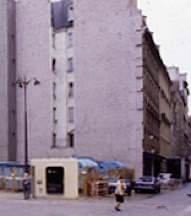
f.The surrounding urban spaces
There are ten new urban spaces and two restored ones around the perimeter of the sequestered garden precinct. They create a variety of places at differing scales and proportion that punctuate sequences of movement along the streets. There is a repetitive 140’ x 140’ module to the square vestibules leading into the Precinct Garden. (21) Two are residential places, the third a room in the museum ground floor that emerges out on the roof as an object of 140’x 140’. The square of trees at the west of the Passage/ Galleria is 140” x 140” and fits inside the ring of trees around the fountain of the innocents on the other side.
Postscript
The Museum of the City drawn by us in 1979 appears as an object that protrudes south into the urban fabric. Its roof faces back becoming a terrace overlooking the interior garden precinct. It seemed an unlikely program proposal for Paris at the time. However, on a recent visit to China in 2012 we encountered newly built museum buildings in both Shanghai and Beijing that were dedicated to the urban design, history, and planning of their cities. This seems to confirm the prescience of our proposal for a similar museum for Les Halles.
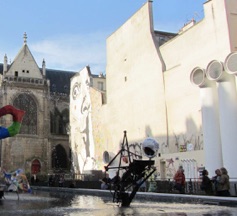





This 2017 version of an article, first published in Architectural Design Magazine, issue #9/10, 1980, was dedicated to design entries to the “Les Halles” competition of 1979. [Consultation Internationale Pour L'Amenagement du Quartier des Halles]. The significance of this open international competition to the architectural discourse was emblematic of the renewed interest in the design of the city at that time. The project illustrated in the following article was authored by Steven Peterson and Barbara Littenberg, with David Cohn. It was one of three Projets Laureates awarded from among the 650 submissions to this competition. This project was the only Les Halles design to be selected for exhibition at the first “Biennale de Paris” at the Centre Pompidou in 1980.
WHAT ARE THE SHAPES OF URBANITY?
The Lessons of Paris
Although this article discusses our specific project for the Les Halles site in Paris, designed in 1979, it is really about the general intentions and purposes of Urban Design. These are simple: the continued reconstruction and future building of the dense, diverse, urban city. This has proved harder to achieve than expected, as we can see in most of the new cities being built around the world today. A human scaled urban fabric with proportional public space is difficult to find.
How to achieve the Aim of Urbanism? This article is our own first attempt at articulating the “Means” toward this end.
AIMS AND MEANS OF URBAN DESIGN
Steven Kent Peterson
A statement

e.The form of the public precinct
The alternative strategy was to develop this whole area of the site as a composite precinct – an urban element that is characterized by its ability to perform in more complicated and deliberately ambiguous ways. Its interior is a figural armature of volumetric space manifest in different ways according to various peripheral conditions. To the south the exhibition building, which is part of the precinct, presents itself as a principal façade somewhat like the walls of an ancient Chateau Fort. (17,18) To the north and west however, the precinct’s object quality is suppressed to integrate it with the surrounding texture. Its walls become housing and its configuration is shaped to correspond with the form of adjacent streets and squares.
Copyright 2017 Peterson Littenberg Architecture and Urban Design 131 East 66th Street, New York, NY 10065

